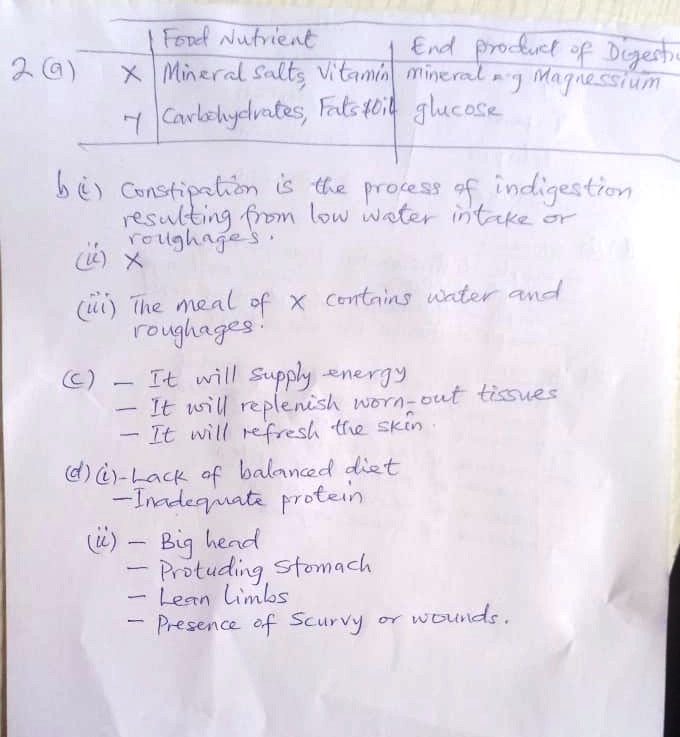FRIDAY, 8th, December, 2023
(8:00am-5:00pm)
Paper 1 & II (Objective & Essay)
(Refresh) Be Checking this Page regularly for Answers.
Our team of expert educators has carefully crafted comprehensive, accurate, and up-to-date answers and questions for this year’s exam, ensuring that you are fully equipped to tackle every challenge that comes your way.
(ads)
To VIEW QUESTIONS ANSWERS, SHARE TO 5 ACTIVE WHATSAPP GROUPS
ESSAY (QUESTIONS AND ANSWERS) LOADING. (After 👇👇Sharing the Link Check back)






3a) Brief Explanation of the Terms:
i) Pathogens:
Pathogens are microorganisms, such as bacteria, viruses, or fungi, that cause diseases in humans, animals, or plants. These microorganisms have the ability to infect and harm the host organism.
(ads)
ii) Health:
Health refers to the overall well-being of an individual, encompassing physical, mental, and social aspects. It is not merely the absence of disease but the state of complete physical, mental, and social well-being.
iii) Sanitation:
Sanitation involves the provision of facilities and services for the safe disposal of human waste, the maintenance of hygienic conditions, and the promotion of cleanliness to prevent the spread of diseases and ensure public health.
(ads)
b) Benefits of Improved Sanitation on a Community:
i) Disease Prevention: Improved sanitation reduces the risk of waterborne and fecal-oral diseases, leading to better overall health in the community.
ii) Environmental Protection: Proper sanitation practices contribute to the protection of the environment by preventing pollution of water sources and soil contamination.
iii) Enhanced Quality of Life: Improved sanitation facilities and practices contribute to a better quality of life by promoting hygiene, dignity, and overall well-being within the community.
(ads)
c) i) What is Sewage?
Sewage is a combination of water-carried wastes, including human feces, urine, laundry waste, and kitchen waste. It also includes industrial and commercial discharges. Sewage is conveyed through a system of pipes for disposal or treatment.
ii) Sources of Sewage:
Two common sources of sewage are domestic sewage, originating from households, and industrial sewage, which includes wastewater from industrial processes and manufacturing activities.
(ads)
d) i) What is Sewage Treatment?
Sewage treatment is the process of removing contaminants and impurities from sewage to make it safe for disposal or to return it to the environment. The treatment involves physical, chemical, and biological processes to eliminate harmful components.
ii) Benefits of Treating Sewage:
i) Environmental Protection: Sewage treatment prevents the release of harmful pollutants into water bodies, safeguarding aquatic ecosystems and protecting the environment.
ii) Public Health Improvement: Treated sewage reduces the risk of waterborne diseases, protecting public health and ensuring the safety of water supplies.
iii) Resource Recovery: Sewage treatment allows for the recovery of valuable resources, such as water and nutrients, from wastewater, promoting sustainability and resource efficiency.
(ads)
5a) (i) Name the biological process demonstrated.
Phototropism.
(ii) Explain briefly the process involved in the observation.
Phototropism is the biological process demonstrated in the observation. It is the growth and bending of plant parts (in this case, cowpea seedlings) towards a light source. The process is regulated by the plant hormone auxin. When the seedlings were covered with a dark box with a hole on one side and exposed to sunlight, the auxin distribution led to cell elongation on the side away from the light, causing the seedlings to grow and bend towards the direction of the hole.
(ads)
(iii) What would happen to the seedlings if there was no hole on the dark box?
If there was no hole on the dark box, the seedlings would not exhibit phototropism. They would grow straight upward without bending towards any specific direction because there would be no directional light cue influencing the distribution of auxin.
b) Explain briefly how carbon (IV) oxide and oxygen balance is carried out in an ecosystem.
The balance of carbon dioxide (CO2) and oxygen (O2) in an ecosystem is maintained through the processes of photosynthesis and respiration. During photosynthesis, green plants and algae take in carbon dioxide from the atmosphere, utilize sunlight, and convert it into glucose and oxygen. This process contributes to the increase of oxygen in the atmosphere and the reduction of carbon dioxide.
(ads)
C(i) Name the main source of energy in an ecosystem.
The sun.
BIOLOGY -OBJ
01-10: BADABABCCC
11-20: DCACCBDABA
21-30: CBAACADBCD
31-40: DACCABBDDA
41-50: AADBDACDDC
completed!!!

.png)

 GET 2024 SIERRALEONE GOVERNMENT WASSCE QUESTIONS AND ANSWERS - Click Here Now!
GET 2024 SIERRALEONE GOVERNMENT WASSCE QUESTIONS AND ANSWERS - Click Here Now!









 Follow
Follow 
.png)
